Europe’s Most Sustainable Destinations

Europe’s most eco-friendly city destinations to visit
Countries around the globe are stepping up their efforts to protect their natural environments, providing an eco-friendly environment for residents and tourists alike.
From cities that offer eco-friendly hotels to those that encourage residents and tourists to use public transport, cycle, and walk, Europe’s top destinations are pledging to be more sustainable and as a result options for eco-conscious travelers are soaring.
So, which cities in Europe are the most sustainable and which are doing their best to protect the planet? To find out, we’ve launched a study analyzing Europe’s most visited cities on a series of sustainable factors.
Get the app to unlock rewards

Book with the app and earn 10% back in Bounce credits. Every booking unlocks more credits for your next trip.
Scan to download

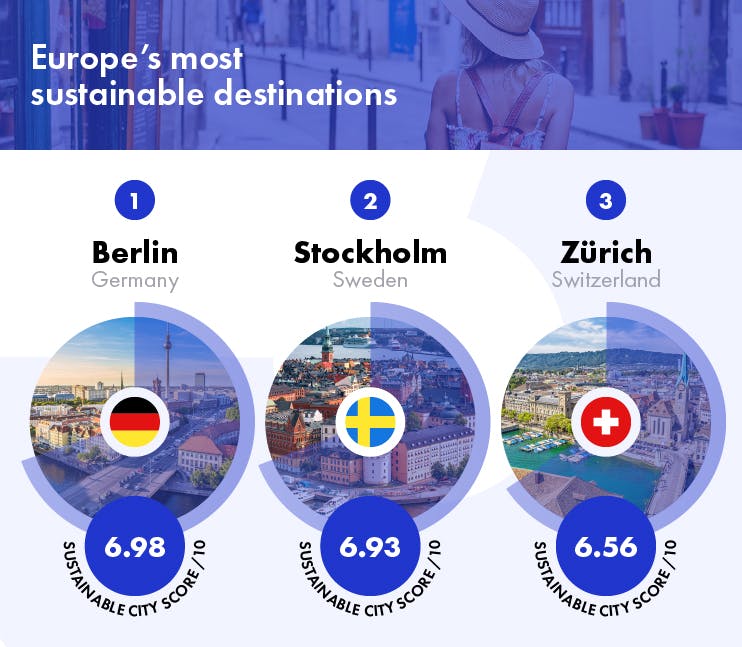
Europe’s most sustainable destinations
1. Berlin, Germany - 6.98 sustainable city score
Topping our list is Berlin, Germany. The city is well known for being a progressive destination, and residents are continuously embracing new green innovations, so it makes sense that sustainability is very important here.
The city of Berlin scores the highest on our list for operating greener ways of commuting, with 84% of residents and tourists choosing to use public transport, walk, or cycle to explore the city. Berlin also leads the way in its green energy performance, using the most nuclear and renewable green energy (2.86%), and the city is home to a number of eco-friendly hotels (9.3%).
2. Stockholm, Sweden - 6.93 sustainable city score
Ranking in second place is the beautiful Swedish city of Stockholm. The city is one of Europe’s most environmentally friendly, thanks to investment in sustainable infrastructures, low emissions, and a low air pollution score (24 out of 100).
The city of Stockholm also scores high on our list for operating greener ways of commuting (80%). Despite being such a populated city, Stockholm has a low carbon footprint (8.1t CO2), and leads a Grow Smarter project, with hopes to be fossil-fuel-free by 2040.
3. Zürich, Switzerland - 6.56 sustainable city score
Zürich is well known for being the financial capital of Switzerland, as well as one of the most expensive cities in Europe. The largest Swiss city has the lowest light pollution of our top three (114μcd/m2) and has a low carbon footprint (11t CO2). It is also the second-highest city on our list to operate greener ways of commuting (82%).
Visitors to Zürich benefit from its efficient public transport system. There are bus or tram stops every 300m of the city. Zürich additionally operates a cap-and-trade scheme on car parking, meaning for every new car park space that is constructed, one must be removed. This method to lower the use of cars in the city encourages travelers to use the efficient and affordable public transport system.
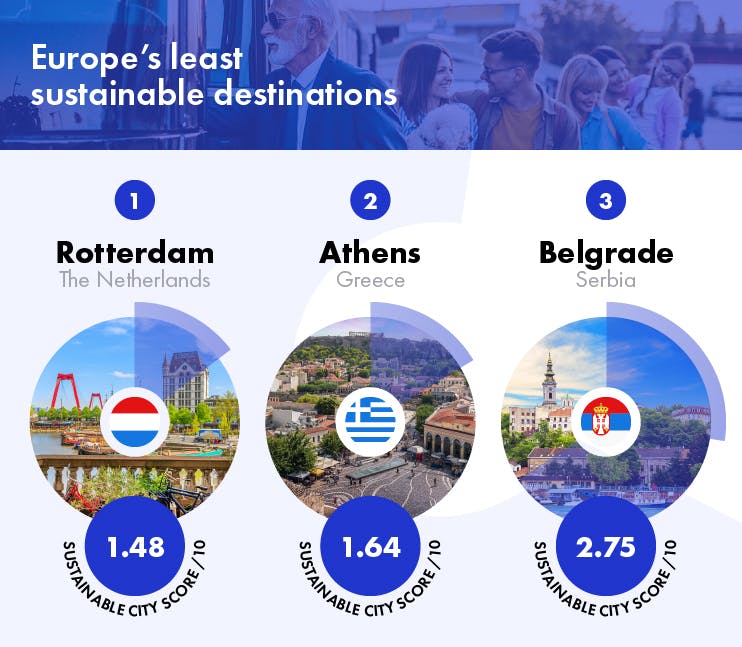
Europe’s least sustainable cities
1. Rotterdam, The Netherlands - 1.48 sustainable city score
The lowest-scoring city on our list is Rotterdam, The Netherlands, the country’s second-largest city, famous for its modern architecture.
Rotterdam scores poorly for its green energy performance (0.25%) and high air pollution (67 out of 100). The city also has a high carbon footprint (11.1t CO2).
One of the main causes of Rotterdam's air pollutants is the continent's largest seaport, based in the city. It was found to be the most polluting port in Europe, producing 13.7 million tonnes of CO2 every year.
2. Athens, Greece - 1.64 sustainable city score
Ranking as the second least sustainable destination for tourists is Athens, Greece. Athens is the seventh-largest city in Europe and it is particularly well known for its vast tourism sector.
Athens scores poorly for its green energy performance (0.18%) and high air pollution levels (69 out of 100). The city likewise ranks the lowest for its total low-impact transport usage (40.6%), with the majority of city dwellers traveling by their car.
3. Belgrade, Serbia - 2.75 sustainable city score
Ranking in third place is Serbia’s capital Belgrade. Belgrade has a high level of air pollution (59 out of 100) and a low number of eco-friendly hotels (2.6%). The city also scores just 0.12% for its green energy performance.
Over the last few years, Belgrade has become one of the most polluted cities in Europe. Factors that contribute to this title include the methods in which people heat their homes, with both firewood and coal being common choices.


The destination with the most eco-friendly hotels
Istanbul, Turkey - 10%
Travelers who wish to travel more sustainably may opt to stay in an eco-friendly hotel, where efforts are made to maintain a minimal rate of energy consumption. The European city that had the highest percentage of eco-friendly hotels by Booking.com is Istanbul, with 10% of total hotels being listed as ‘eco-friendly’.
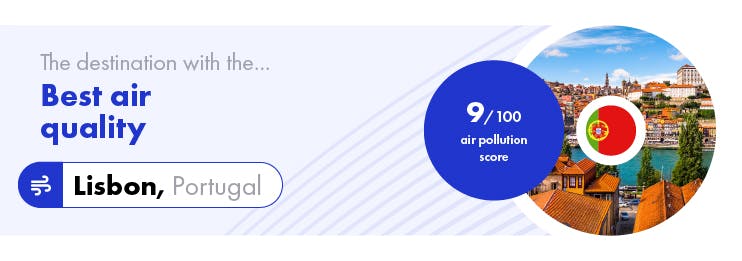
The destination with the best air quality
Lisbon, Portugal - 9 out of 100 air pollution score
Despite Lisbon’s humidity, the city ranks number one for its air quality. The Portuguese city of Lisbon won the European Green Capital 2020 award, thanks to its 50% reduction in CO2 emissions between 2007 and 2014.
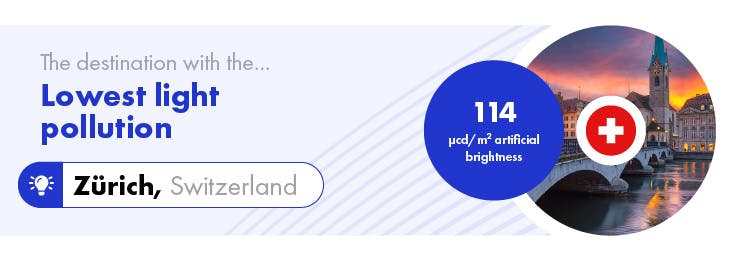
The destination with the lowest light pollution
Zürich, Switzerland - 114 μcd/m2 artificial brightness
Light pollution is often overlooked when considering how polluted our cities are. However, excessive or inappropriate use of artificial light can have a serious environmental impact on humans, wildlife, and our climate.
Zürich, Switzerland, has light pollution of just 114 μcd/m2. City planners here use white light bulbs (as opposed to orange/yellow) to give a more natural look that complements the local architecture.
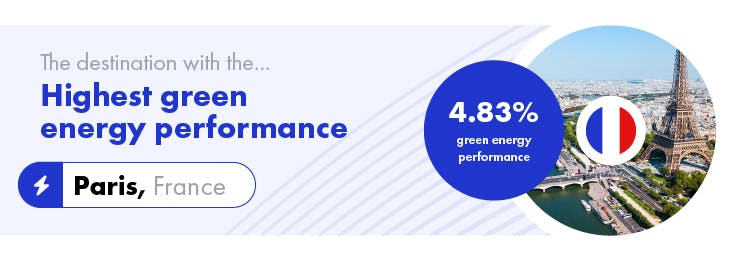
The destination with the highest green energy performance
Paris, France - 4.83% green energy performance
Unfortunately, green energy consumption is only available at country level rather than the city, but the European country where green energy makes the largest share of consumption is France, at 4.825%.
France’s electricity supply is dominated by nuclear and renewables, with hydropower being the predominant renewable source. The country is the third-largest European producer of hydroelectricity behind Norway and Turkey.
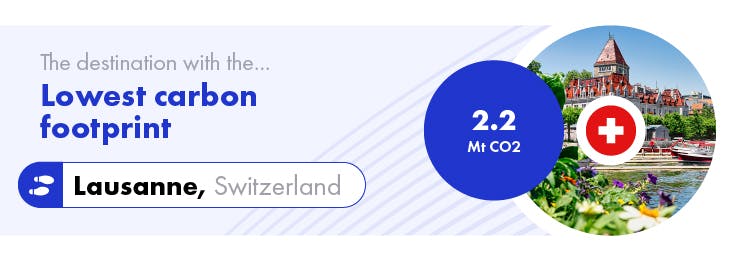
The destination with the lowest carbon footprint
Lausanne, Switzerland - 2.2 Mt CO2
Lausanne, Switzerland, ranks as the city with the lowest rate of carbon footprint, with just 2.2 metric tonnes of carbon dioxide equivalent.
Lausanne is the most environmental Swiss city, according to the WWF, thanks to its tree-planting initiatives, and a zero CO2 emission target for mobility by 2030.
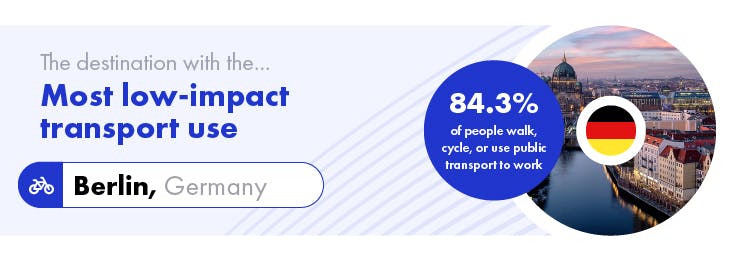
The destination with the most low-impact transport use
Berlin, Germany - 84.3% of people walk, cycle, or use public transport to work
Opting to use public transport, walking, or cycling to commute is a much greener way of traveling and reducing your carbon footprint, and by far where car usage is at its lowest, is Berlin, Germany.
Here, 84.3% of people use either public transport, bicycles or foot to get to work and school.
The German city has developed a highly complex transportation infrastructure in recent years, providing diverse methods of travel.
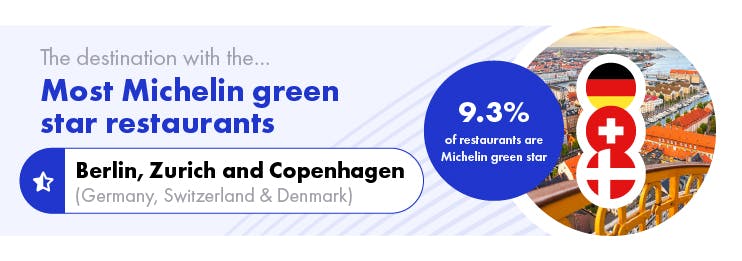
The destination with the most Michelin green star restaurants: Berlin, Zurich, and Copenhagen - Michelin green star restaurants (9.3%)
One of the new and upcoming concepts for reducing energy consumption within the service industry is green Michelin star restaurants. These establishments are recognized specifically for their sustainable practices.
The three cities of Berlin, Zurich, and Copenhagen are each well known for their green star restaurants, with 9.3% of the Michelin restaurants in each city being awarded this status.
Methodology
A list of 28 European cities was compiled, with any that didn’t have full comparable data for each factor being removed.
The remaining cities were then analyzed on the following factors, with each one given a normalized score out of 10 before an average of these scores was taken.
Sustainable hotels
The percentage of the total hotels listed on Booking.com that have been designated ‘Travel Sustainable properties’.
Public transport use
The percentage of people that either walk, cycle or use public transport to get to work or school, according to each city’s ‘Traffic’ page on Numbeo.
Air quality
The annual air pollution in the city for 2021 according to IQAir’s world’s most polluted cities data.
Green energy performance
The consumption of renewable energy for each city according to EIA Independent Statistics & Analysis.
Light pollution
The artificial brightness in the city center according to LightPollutionMap.info.
Carbon footprint
The total carbon footprint (Metric Tonnes of CO2) according to the Global Gridded Model of Carbon Footprints (GGMCF).
Michelin green star restaurants
The percentage of Michelin restaurants awarded a green star according to the Michelin Guide.
Get the app to unlock rewards

Book with the app and earn 10% back in Bounce credits. Every booking unlocks more credits for your next trip.
Scan to download

